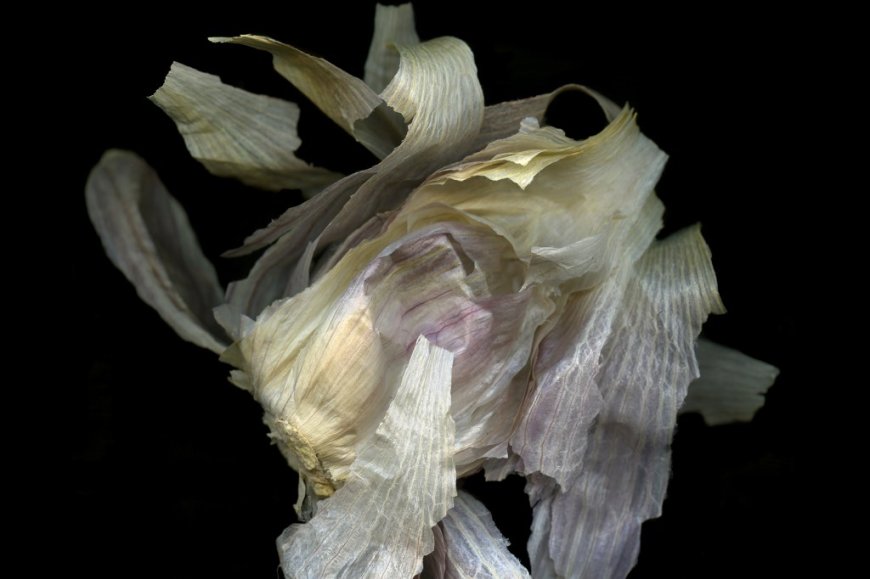Discover the Beauty of Kitchen Scraps in Art Exhibition
Explore Rebecca Whittemore's unique art series showcasing the beauty of discarded kitchen scraps. Through high-definition scanograms, she captures the texture and character of food scraps, inviting viewers to reflect on wastefulness and appreciate the overlooked. The exhibition, 'What the Kitchen Forgets,' is a visual journey into the art of decay, highlighting the intricate details and unexpected beauty in everyday remnants.

Plump, glossy produce is the traditional subject of still life, but Rebecca Whittemore is more interested in what happens next, when the fruit and vegetables are chopped, their unwanted parts discarded and left to rot. There is also the before, when supermarkets throw away flawed goods before they can even hit the shelves. Her work reveals the beauty in what we discard and encourages us to reflect on wastefulness.
What the Kitchen Forgets is somewhat ironic in its location at Gallery M adjacent to Westfield Marion, the largest shopping centre in the state where everything is fresh off the shelf, while the exhibition is an appreciation of the old — and bound for the bin.
Whittemore’s 13-piece series explores the texture and character of food scraps via high-definition scanograms — images produced by a photocopier for three-dimensional objects. The scanner’s built-in light source captures its subjects with extreme sharpness and saturation, causing them to leap off the black background with dramatic depth and shadow effect.
The items are placed directly on the scanner bed, with dust and other particles often landing on the glass, such as in Zucchini and Carrot Peels. Composed in a halo-like shape, the peels resemble the falling ingredients of a burger in a fast food commercial, with the dust akin to water droplets. If this were the children’s stop-motion cartoon Soupe Opera, the peels would transform into a wiggling wreath of worms, snakes or seahorses — an oceanic theme that continues in other pieces.
Across the exhibition, the scraps could also be perceived as floating as they gently tumble into the darkness of a bin, or the underworld. Fortunately, we are spared from any pungence.
The natural world is evoked throughout the series, with Potato Skins reminiscent of cave icicles, staghorn coral or tree roots, and a red bird with giant green wings appears in Strawberry. The face of a goat, meanwhile, forms in the gruff and rugged Broccoli. Burnt Pumpkin Skin mimics an autumnal maple leaf in its caramelised colouring, and similarly Fryer Residue echoes crystallised tree sap.
Personal favourite Red Onion is elegant and sophisticated, bolstered by the strong black framing all the pieces could have benefitted from. The onion’s drying layers remain rich in their beetroot colouring, resembling a wilting rose, as well as a human organ, mighty shell or foliose coral.
Lettuce is similarly striking but delicate, as wrinkled and tissue-paper-thin as the skin of a grandmother’s hands. In contrast, Sweet Potato is almost unrecognisable except for its rough exterior, looking like a weathered shell a hermit crab could crawl out from.
Mandarin, of which it is just the pith, continues the oceanic theme in its appearance as fluffy, fluid seaweed. Green Onions, with only their roots visible, could be playful sea creatures with unwieldy legs, or neurons firing around the body. The composition of each piece is commendable for evoking a mood of fun, peace or solemnity respectively.
The human body is evident again in Garlic Skin, scientific in its purple veins and intricate cellular makeup, while Cauliflower Leaf would be unimpressive if not for its wrinkles and folds.
In keeping with the exhibition’s themes, Whittemore is donating 10 per cent of sales from the exhibition to OzHarvest, Australia’s leading food rescue organisation.
Despite the decay of her subjects, they are arguably more beautiful and interesting in this aged form, enticing us to lose ourselves in the intricacies. The exhibition suggests that even in death, there is life, and a story to be told.
What the Kitchen Forgets is showing at Gallery M until July 5, with a ‘Meet the Artist’ session on Saturday June 28 at 1pm.
Sarah Herrmann is the latest recipient of the Helpmann Academy InReview Mentorship. She is working with experienced visual arts writer Jane Llewellyn to write a series of articles for publication in InReview, funded by the Helpmann Academy.
What's Your Reaction?
 Like
0
Like
0
 Dislike
0
Dislike
0
 Love
0
Love
0
 Funny
0
Funny
0
 Angry
0
Angry
0
 Sad
0
Sad
0
 Wow
0
Wow
0



















































































































































